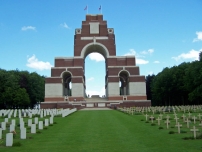| First Name: | William | Last Name: | ANNELL | |
|---|---|---|---|---|
| Date of Death: | 15/09/1916 | Lived/Born In: | Regent's Park | |
| Rank: | Private | Unit: | London1 | |
| Memorial Site: | 1. South Camden, St Mary Magdalene 2. Thiepval Memorial, France | |||
Current Information:Age-19 136, Albany Street, Regents Park
The Battle of the Somme (July-November, 1916) By the beginning of September, 1916, the Battle of the Somme had been raging for two months. Thousands of men had already been killed or wounded or were simply missing, never to be seen again and and just a few square miles of the French countryside, all in the southern part of the battlefield, had been captured from the enemy. Mistakes had been made by the various commanders and would be continued to be made but there was no turning back as the British, Australians, South Africans, New Zealanders and Canadians carried on battering away at the German defences in the hope of a breakthrough, So it continued all the way through to November with nearly every battalion and division then in France being drawn into it at some stage. In the end the German trenches had been pushed back a few more miles along most of the line but the cost in lives had been staggering. By the end of the fighting in November, 1916, British Army casualties numbered over 400,000, killed, wounded and missing. On 15th September, 1916, the offensive on the Somme was renewed with a full scale attack on the German 3rd line of defences. Four Army Corps were used on a front that stretched from Combles, through the village of Flers and on to Courcelette.. The artillery barrage that preceded this attack was more concentrated than that on 1st July and the attack itself was more successful. The villages of Flers, Martinpuich and Courcelette were captured and the enemy was finally pushed out of High Wood, but the breakthrough was not achieved and the reality was that when the battle ended on 22nd September, the front line had just been moved forward a mile or so. The battle is notable for being the first time that tanks were used. At the beginning of the Battle of Flers-Courcelette, 56th Division attacked on the extreme right of the British line, next to the French and had the task of forming a defensive flank along the north-west slopes of the Combles Ravine. 1st London of 167 Brigade attacked on the left of the divisional front, with the objective of extending this defensive flank northwards through Bouleaux Wood. They had two tanks attached to assist them in this task but one of them split a track while moving up and could not take part and the other got as far as the German line where it was hit and abandoned. At 6.20am, 1st London attacked behind an ineffectual creeping barrage and when ‘A’ and ‘B’ Companies closed on the enemy trench they found it undamaged and fully manned. They were stopped in their tracks by a combination of wire entanglements and machine-gun fire. To their left ‘D’ Company were more successful. They took their objective and went on to capture Middle Copse but with both flanks exposed they eventually had to withdraw from this advanced position. 1st London’s casualty list for the day was very long. Nearly 300 officers and men were either killed, wounded or missing. One of those killed was William Annell. |
||||
| « Back to Search Results | ||||
| If you think any of the information shown here is incorrect, Click Here to submit your amends and comments | ||||




